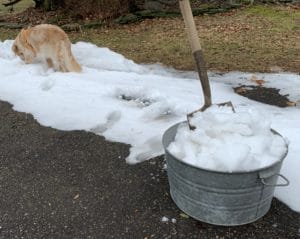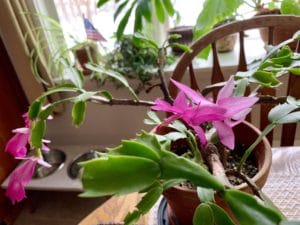Hello Fellow Readers, There’s Christmas cactus that came my way by adoption from a then-husband, a story shared in a column long ago (link below). Neglected and riddled with old deadwood, I revived it, and it bloomed beautifully for many years. Then it mysteriously returned to its stick-like state and stopped blooming until, by accident, I discovered the benefits of watering with rainwater.
I have a tough time tossing plants.
Like many things that come with memories, I have a tough time tossing them. Especially plants; they’re living things, after all.
So as a last attempt before the compost pile, my Christmas cactus spent the summer outside on a garden table. Chipmunks that live in the rock wall opposing the spot nibbled the roots. Then moss took up residence, creating a plush blanket below the cactus. As the rainy summer unfolded, it came back to life.
Perhaps the root-pruning of the chipmunks helped. For sure, the nitrogen from the rainwater did, increasing the fertility of the soil. Plus, rain brings oxygen to roots, which, especially for succulents, keeps them from suffocating in flooding conditions. I moved the cactus indoors before the frost, and low and behold; it’s blooming once again!
Benefits of watering with rainwater or melted snow:
It hadn’t occurred to me until the turnaround to use rainwater to water indoor plants. Rain is free from salts and treatment chemicals found in public water and surface or groundwater, which more dramatically accumulates in potted plants. Sadly, even well water is not what it used to be due to chemical pesticides since the mid-1940s. The overuse of phosphates has impacted soil, thereby causing water to become out of balance.
Rainwater is an ideal pH 7, slightly acidic, unlike municipal water typically kept alkaline to preserve pipes. Plus, one of the critical nutrients a plant needs to survive is nitrates, a combination of nitrogen and oxygen found in rainwater.
Rainwater (& Snow) Harvesting
Rainwater harvesting began in ancient times and is growing in popularity with home gardeners. By collecting rainwater from roof runoff into a rain barrel, you gather the benefits of organic material from plant debris, pollen, and bird droppings. And the barrel itself creates an environment that keeps the water alive, offering nutrients to plants every time you water.
 So Santa, a rain barrel is a perfect gift to look forward to putting into use come spring. During the winter months, why not gather snow in five-gallon buckets and allow it to melt to room temperature to treat your indoor plants to a nutritious boost. You can save some melted snow in repurposed milk jugs between snowfalls too. See that, snow naysayers; Frosty can be very welcome coming back to town.
So Santa, a rain barrel is a perfect gift to look forward to putting into use come spring. During the winter months, why not gather snow in five-gallon buckets and allow it to melt to room temperature to treat your indoor plants to a nutritious boost. You can save some melted snow in repurposed milk jugs between snowfalls too. See that, snow naysayers; Frosty can be very welcome coming back to town.
Garden Dilemmas? AskMaryStone@gmail.com (and your favorite Podcast App.)
More about my cactus and the difference between Thanksgiving vs. Christmas Cactus
Column updated 11/14/21



